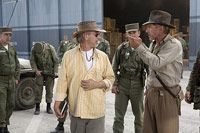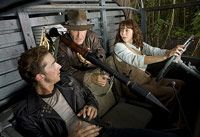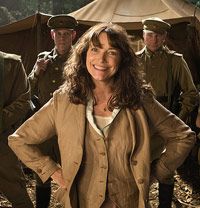When they sent me to ILM about a month ago, they sent us to talk to some of the geniuses behind the astonishing visual effects behind two of the biggest films of the year's DVD releases: Iron Man (CLICK HERE to check that piece out) and Indiana Jones and the Kingdom of the Crystal Skull. Since Indiana Jones and the Kingdom of the Crystal Skull hits the DVD shelves on October 14, what better time to post the conclusion of my day at the fabulous Industrial Light and Magic facilities.
For our Indiana Jones and the Kingdom of the Crystal Skull leg of our visit, our press corps met with two of the visual effects artists responsible for bringing these amazing effects to life. Pablo Helman was the Visual Effects Supervisor on the film and he's been with ILM since 1996. He has worked his way up through the ILM ranks, from just a digital artist on Men In Black to his Oscar-nominated work as Visual Effects Supervisor on Star Wars: Episode II - Attack Of The Clones and War of the Worlds to his work on Indiana Jones and the Kingdom of the Crystal Skull. We also spoke with Christian Alzmann, the Visual Effects Art Director on the film, who's been with ILM since 1999. After cutting his teeth as a Storyboard/Concept Artist on such films as Space Cowboys and Harry Potter and the Sorcerer's Stone and many others, he's served as Visual Effects Art Director on such films as War of the Worlds, Eragon, The Spiderwick Chronicles and Indiana Jones and the Kingdom of the Crystal Skull. We strapped in for an hour-long presentation by the two visual effects artists and there was much we learned about the effects of this blockbuster film.
Helman started out by telling us their first meeting with George Lucas and Steven Spielberg, where Spielberg said that, "he wanted to go back to the other three movies. That was his vision. He wanted to do some of the same lenses that he used in the other three movies. Everything was going to be shot anamorphic. It was going to be epic." He also added that Spielberg, "has this uncanny ability to do a movie that is completely intimate and very very small and to do a huge epic. Here I was going to be treated to seeing how he was going to solve that." He also said that there were 10 weeks of principal photography that he was on the set with him and, "I have to absorb everything he has to say and I have to become his eyes."
Helman went on and said that three of the challenges on this film were environment, creatures and simulations. In terms of environment, "Steven said he wanted everything to look organic." They showed us some of the footage of the thrilling chase scene right at the edge of the cliff, and they explained how they shot parts of that scene with the helicopter that gave it, "pretty much the movement and the framing of it, but a lot of it was replaced." They then talked about merging shots from other locations into the cliff scene, with them shooting the scene on a regular road, and basically digitally creating a cliff around the driving, which is pretty damn cool. Helman also said he wanted, "at least 50 percent of the image on camera," with his work consisting of the rest of the shot you see in the film.
It was asked how much influence George Lucas had on this side, or if it was all Spielberg. Helman replied, "Yeah, there was a bit from George. He does have a different kind of way of looking at things. It's kind of interesting. They're very similar in lots of ways, but they're very different, in the way they'd like to shoot the movie, for instance," meaning Lucas' propensity towards digital while Steven still loves shooting on film. "That's another thing that came out in the last interview too. This show was edited on film, so that was like an incredible change for George, because Steven likes to touch the film and cut it and put it together and change it. Michael Kahn is also a traditional editor and from our point of view, it doesn't make any difference, but the movie itself, gets put together as we shoot it, actually, on location. Five weeks into the shoot, we already have five weeks worth of movie there. Steven does take a look at that. He works with the editor that's on location every day. Sometimes I even look at the edit, because we don't know how it's going to work, or if it's going to work and it needs to be reshot."
They moved on to the famous ant scene and Alzmann had some interesting tidbits about Spielberg's wishes for this scene. "The stuff hitting the lens, Steven was really big on pushing us to get everything as dirty as possible throughout our effects, to kind of get rid of that cleanliness that you can't sort of help but get when you do digital work. So, he wanted stuff to look like mistakes and little glitches that might happen on set when you're filming, like when a cameraman is trying to catch up with something. He was like, 'Add this and add that,' anything he could to give it this real Indiana Jones action-adventure kind of quality."
Someone noted on how Spielberg seems very collaborative, and Helman did agree. "Yeah. It's so strange to see those kinds of things from someone who's made 30 movies and is who he is, but he's very collaborative." He then told a story about the early nuclear explosion scene which just shows how brilliant Spielberg really is. "We got to the set in the morning and he said to be, 'Are we shooting this way or that way? Are we shooting into the sun?' He was wiling to work with us. I said, 'Well, we should shoot it into the sun because that's where the atomic explosion is going to be and we're going to use that. He said, 'Well, why don't we use the sun for the sun for the sun and we put the atomic explosion on the side and we make a triangle between the sun, Indy and the atomic explosion.' That's basically, just the icing on the cake."
Alzmann also talked about, since this is a Lucas film and pretty much home territory at ILM, how that sort of mentality played into the work. "For me, Raiders and the trilogy are just some of the movies that made me want to do this, Star Wars and Indy. To get to be a part of that, yeah, it's very precious to all of us. I think there's a little bit of that much more care. I didn't want anything I drew or designed to be weaker than anything that came before, so there's that much more pressure. I definitely put more pressure on myself, I think."
As we were wrapping up, it was asked about 3-D and their thoughts on the new wave of that format and whether they would be involved. Helman responded, "I think it's an interesting aesthetic. Two hours is a long time for people to be there with glasses on. I think it's also, it depends on how you shoot it too. There's a technology that goes along with that aesthetic. If you use really long lenses, it looks very cardboard and if you use wide lenses, your eye gets really tired. There's a lot of physics to it too. There's also the business aspect of it, which is whether you have enough screens that will support that kind of technology."
Indiana Jones and the Kingdom of the Crystal Skull ILM Visit #5They were also asked if they can separate themselves from their work and actually go to a movie and enjoy it. "I really try," Alzmann said. "I really try. I think most of us were movie geeks at heart and I want to see it as an 8-year-old kid, if possible. I don't want to think about the wizard behind the curtain at all. That is, unless it's a glaringly bad effect, it pops out." Helman, however, is able to, "turn it off completely."
And with that, my day at ILM came to a close. It was a phenomenal day at this truly legendary facility and I simply can't wait to go back again. Seriously. Waiting with baited breath here. Indiana Jones and the Kingdom of the Crystal Skull comes to DVD and, of course, Blu-ray on October 14 and you can see all of the magical work Helman and Alzmann did for the movie. Peace in. Gallagher out!



